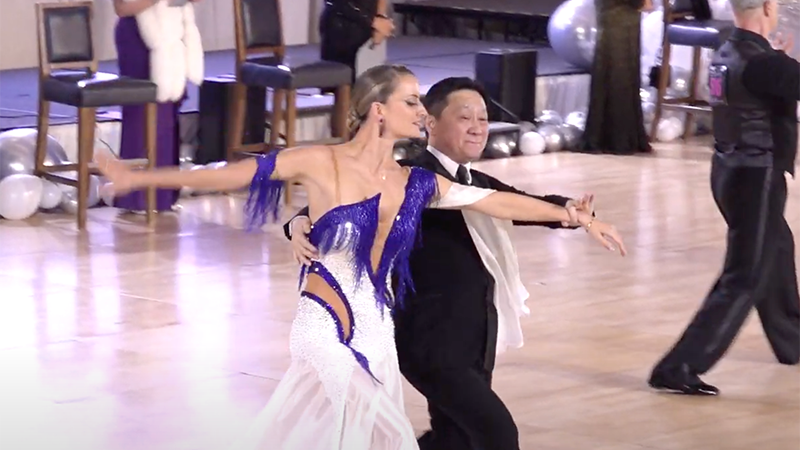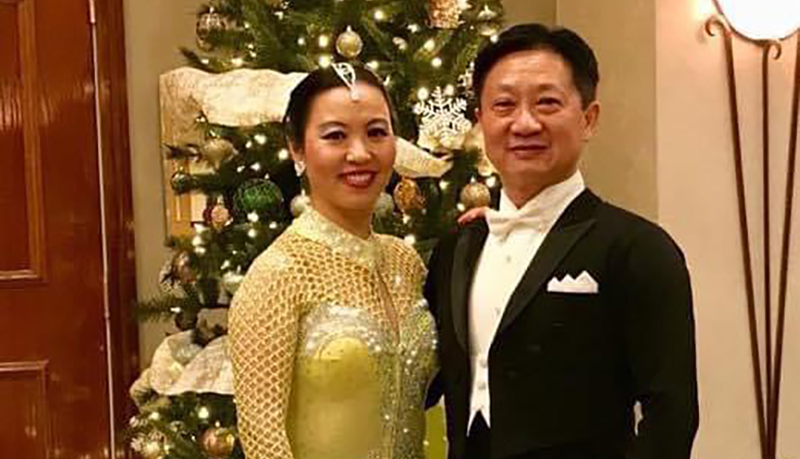Johnny Tang has spent decades finding the best ways to optimize performance, offering continuous monitoring and feedback, diagnosing problems and troubleshooting, maximizing efficiency, and executing a polished production.
And that’s not only what he must do in his role as a controls software engineer at Oak Ridge National Laboratory’s Spallation Neutron Source.
That’s also his focus as a competitive ballroom dancer.
Born in Shanghai, Tang immigrated to the United States to pursue higher education in one of the best graduate schools. He has always been interested in dancing and was active in school dancing programs. He was first introduced to ballroom dancing while pursuing his master’s degree in physics at the College of William and Mary, where he became an active member of the ballroom dance team.
Ballroom dancing provided Tang with an outlet while in school, serving as a healthy distraction from the pressure of class and introducing him to new people. He remembers those years fondly.
“It’s like my first stage of life. It was full of school sports, becoming a United States citizen in 1990, and becoming a mature staff scientist. During that time, I was learning not only about science and physics, but dance as well.”
Since his introduction to ballroom dancing in 1992, Tang has participated in local, regional, and national ballroom dance competitions along the East Coast, as well as local charity events like Dancing with the Knoxville Stars for East Tennessee Children’s Hospital in 2014. Tang placed first in that event with his then-partner.
Currently, Tang and his wife, Jun Anna Tang, are training under the guidance of Jaimee Tuft to participate in the United States Dance Championship in September 2024. Tang will compete with his wife in the Amateur-Amateur category, and with Jaimee Tuft in the Professional-Amateur category. He has competed with other dance partners and competes in several categories, including waltz, tango, foxtrot, quickstep, and Viennese waltz.
In 1997, he earned his Dual Fellows title in International Ballroom, Latin, American Smooth, Rhythm and Theatre Arts from the prestigious United States Terpsichore Association. He said he seeks the best coaches in the ballroom industry for knowledge and guidance for his dancing.
For Tang, dance teaches determination as well as the importance of never giving up in order to reach milestones. This is a practice that carries over into his role as a controls system engineer. In Tang’s mind, science and dance are interwoven. When he describes the waltz’s signature moves, he uses what he calls his “engineering brain” to break down the movements so they resemble a fluid operation.
“I imagine each dance on a scale of 0 to 10 to show its characteristics. The waltz is soft, so it’s a four or a five. It’s a dance where you find love, lose love, and then find it once more. Then, there’s the foxtrot. It ranges from a six to a 10. It’s strong and tells its own story.”
When asked which is his favorite dance, Tang smiled. “I like them all. Though if I must pick, foxtrot would be my favorite even if it is my weakest.”
Tang did not anticipate he would still be dancing decades after his college days. “I didn’t know then, but I just started really enjoying it. Dancing really balanced my life.”
Ballroom dancing gave Tang a sense of community while in school, and again at Jefferson National Laboratory, then at Brookhaven National Laboratory, and later at ORNL in 2002. When Tang first arrived at ORNL, word quickly spread of his hobby, and a member of Human Resources introduced Tang to what would become his second home: The Dance Centre of Oak Ridge. There, Tang would soon earn a new title—Certified Fellow Ballroom Dance Teacher.
The transition to teaching was easy for Tang, who continued competing as well. He was excited at the prospect of giving back to the community. Though he has since moved from The Dance Centre of Oak Ridge to Timeless Ballroom in Knoxville, Tang continues to offer classes that welcome people of all ages, backgrounds, and skill levels.
A current dance student of his, Si Athena Chen, works at ORNL’s High Flux Isotope Reactor (HFIR) as a neutron scattering scientist in the Powder Diffraction Group; diffraction is one of several neutron scattering techniques.
Neutron scattering at HFIR and SNS provides information about the positions, motions, and magnetic properties of materials. When a beam of neutrons is aimed at a sample, many neutrons pass through the material, but some interact directly with atomic nuclei and “bounce” away at an angle, like colliding balls in a game of pool. Using special detectors, scientists count scattered neutrons, measure their energies and the angles at which they scatter, and map their final position. This makes it possible for scientists to glean details about the nature of materials ranging from liquid crystals to superconducting ceramics, from proteins to plastics, and from metals to metallic glass magnets.
Chen found Tang’s class last October. As a former dancer, Chen has been a regular participant since.
“What I like most about Johnny’s class is the structured syllabus and the specific steps we cover in each class,” said Chen. “I’ve continued with his teaching because he’s a kind and passionate instructor. You can tell he loves to dance, and he really enjoys teaching.”
As it did for Tang, dance helped Chen’s work and life. “Johnny has built a very nice ballroom dance community, and I’ve made a lot of friends in his and his wife’s classes. Their classes have made me happier, giving me a fulfilling life outside of work.”
Along with his regular classes, Tang offers a free class every Friday for beginners unsure if they are ready to invest in ballroom dancing.
Tang considers teaching to be rewarding, adding that he often learns from his students. One student, a doctor, taught him the differences between the left brain and right brain, especially helpful information for an engineer, he said.
“Just because you may be physically tired doesn’t mean your brain is also tired. Similarly, just because the more analytical left brain might be more tired after a full day of working at the lab doesn’t mean the more creative right side is also tired.”
It is all about balance for Tang, which he said, “is key to productivity and being happy at work, as well as in life.”
UT-Battelle manages ORNL for DOE’s Office of Science, the single largest supporter of basic research in the physical sciences in the United States. The Office of Science is working to address some of the most pressing challenges of our time. For more information, please visit https://energy.gov/science — Kaeli Swaggerty.




